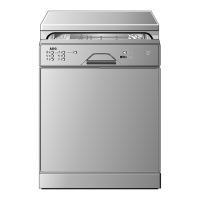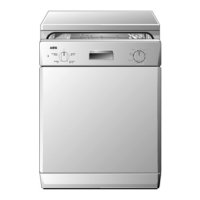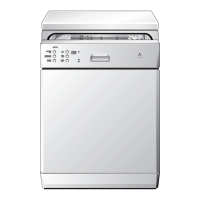
Do you have a question about the AEG OKO FAVORIT 6480 and is the answer not in the manual?
| Type | Freestanding |
|---|---|
| Capacity | 12 place settings |
| Washing Performance | A |
| Drying Performance | A |
| Number of Programs | 5 |
| Delay Start | Yes |
| Half Load Option | Yes |
| Dimensions (H x W x D) | 850 x 600 x 600 mm |
Only use dishwasher for household crockery. Do not convert or modify the appliance for safety reasons.
Check for transport damage, ensure correct installation, and match voltage/current to the rating plate.
Keep packaging away from children. Ensure supervision during operation and keep detergents out of reach.
Never operate with damaged parts. Turn off water and unplug for faults. Handle plug by the body, not cable.
Packaging materials are eco-compatible. Dispose of packaging at your local recycling centre.
Render old machine unserviceable before disposal. Disable door lock and discard electrical lead.
Wash with full baskets. Select appropriate programmes. Do not overdose detergent, salt, or rinse-aid.
Identify unsuitable items like wooden boards, plastic parts, and certain metals. Note limitations for decorated items.
Diagram identifying key internal parts: upper/lower baskets, spray arms, filters, detergent dispenser, salt container.
Explanation of buttons, display, and indicator lights for operating the dishwasher programmes.
Details on the pilot light, On/Off button, and Programme selector pushbuttons for machine operation.
Explanation of the display for programme duration and the programme sequence indicator lights.
Meaning of control lights for salt refill, rinse aid refill, closed tap, and opened door.
Table detailing programmes, soil types, load types, and required buttons for effective dishwashing.
Information on water hardness levels and how to set the water softener for optimal results.
Step-by-step guide to adjust the water hardness level on the display using the control buttons.
Instructions for filling the salt container with dishwasher salt and the salt refill indicator.
Information on rinse-aid function, filling the dispenser, and the rinse-aid replenishment indicator.
Regulating the rinse-aid dosage based on drying results using the six-position selector.
Guidelines for using dishwasher detergent, including dispenser reference marks and prewash requirements.
Explanation of low-alkaline compact powders with natural enzymes and their benefits for cleaning and environment.
Instructions for loading saucepans, lids, plates, and bowls into the lower basket for optimal washing.
Details on lowering the rear rows of prongs in the lower basket to accommodate pots, pans, and bowls.
Guidance on placing knives, forks, and spoons in the cutlery basket for best washing results.
Instructions for arranging plates, bowls, cups, and glasses in the upper basket, including long-stemmed glasses.
Procedure for moving the upper basket to a higher position to accommodate larger plates in the lower basket.
Steps to select and start a washing programme, including delay start and partial load options.
What happens at the end of a cycle, including stopping the machine and removing dishes.
How to safely interrupt, change, or cancel a running programme.
Guidelines for cleaning the dishwasher's interior, exterior, and spray arms with appropriate cleaning agents.
Instructions for removing and cleaning the central and large filters to ensure proper operation.
Explanation of flashing alarms (A6, A3, A1, A2, A7) and basic troubleshooting steps.
Troubleshooting for issues like the machine not filling with water or not starting.
Addressing issues like dirty dishes due to overloading, improper arrangement, or clogged spray arms/filters.
Resolving issues related to lime deposits, white film, excessive noise, and rattling dishes.
Solutions for dishes not drying properly and difficulties in closing the dishwasher door.
Information on contacting customer service, quoting E-No. and F-No. for precise identification.
Details on capacity (place settings) and allowable water pressure range for the dishwasher.
Instructions for positioning the dishwasher close to water/waste connections and ensuring it is level.
Procedure for moving the work-top forward or backward to fit precisely against kitchen cabinets.
Guidelines for fitting a custom decor panel onto the dishwasher door for aesthetic integration.
Notes on steam protection for worktops and ensuring free movement of hoses in the recess.
Instructions for connecting the dishwasher to cold or hot water supply, including pressure requirements.
Methods for connecting the drain hose to a sink siphon or wall outlet, and height requirements.
Guidelines for extending the drain hose, including length and diameter restrictions.
Description of the water protection system, including overflow and outlet protection features.
Ensuring correct electrical connection, voltage compatibility, load capacity, and earthing for safety.










